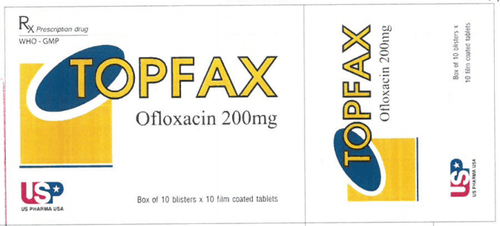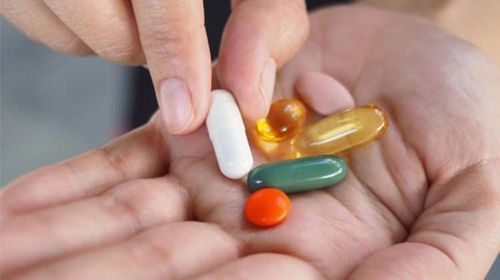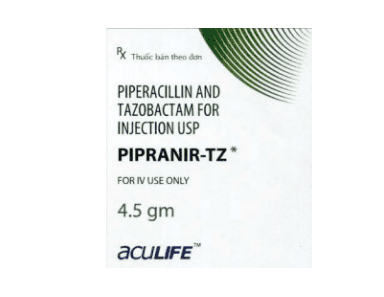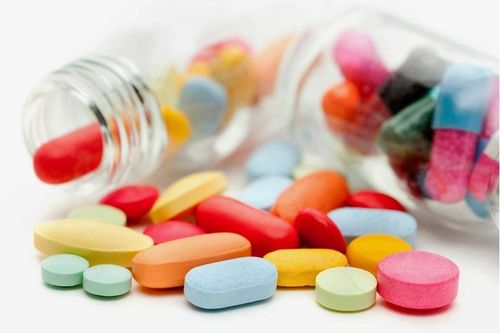This is an automatically translated article.
Ofloxacin is a medication commonly prescribed in the treatment of certain bacterial infections. So what is the effect of Ofloxacin and how is it used?1. The effects of the drug Ofloxacin
Ofloxacin medicine is produced in the form of film-coated tablets, the main ingredient in each tablet is Ofloxacin 200mg. Ofloxacin is a fluoroquinolone antibiotic with a broad spectrum of antibacterial activity including Pseudomonas aeruginosa, Haemophilus influenzae, Enterobacteriaceae, Staphylococcus, Streptococcus pneumoniae, Neisseria spp., Chlamydia trachomatis, Mycoplasma pneumoniae, Mycobacterium Leprae, Mycobacterium tuberculosis and Mycobacterium spp. another, Ureaplasma urealyticum.To date, the mechanism of action of Ofloxacin is not fully known. Like other quinolones, Ofloxacin inhibits DNA-gyrase, an enzyme necessary for bacterial DNA replication, transcription, and repair.
Ofloxacin is used in infections caused by susceptible bacteria, such as:
Severe bacterial bronchitis. Pneumonia. Chlamydia infection of the cervix or urethra with or without gonorrhea. Uncomplicated gonorrhea. Prostatitis. Urinary tract infections. Skin and soft tissue infections. Inflammation of the colon caused by bacteria. Ofloxacin is contraindicated in the following cases:
People with hypersensitivity to any of the components of the drug. Children under 15 years of age Pregnant and lactating women. Use caution when using Ofloxacin in the following cases:
People with epilepsy or a history of central nervous system disorders. Reduce dosage for patients with renal failure. Discontinue treatment with Ofloxacin if the patient develops psychiatric, neurological and hypersensitivity reactions (severe rash).
2. Dosage and usage of Ofloxacin
Ofloxacin is taken orally. Dosage of Ofloxacin should be according to the doctor's prescription. Reference dose for specific cases is as follows:Bronchitis or pneumonia: Use 400mg dose every 12 hours, continuously for 10 days. Chlamydia infection in the cervix and ureters: Use a dose of Ofloxacin 300mg, every 12 hours, for 7 days. Uncomplicated gonorrhea: Use a dose of 400mg, a single dose. Prostatitis Use a dose of Ofloxacin 300mg, every 12 hours, for 6 weeks. Skin and soft tissue infections: Use a dose of 400mg, every 12 hours, for 10 days. Urinary tract infections Cystitis caused by E. coli or K. pneumoniae: Use a dose of 200mg, every 12 hours, for 3 days. Cystitis caused by other bacteria: Use 200mg dose, every 12 hours, for 7 days. Complicated urinary tract infections: Use a dose of 200mg, every 12 hours, for 10 days. Adults with renal impairment: Creatinine clearance > 50ml/min: Ofloxacin dose unchanged, taken every 12 hours. Creatinine clearance: 10 - 50ml/min: Ofloxacin dose unchanged, taken every 24 hours. Creatinine clearance < 10 ml/min: Use half dose, every 24 hours. Ofloxacin overdose reactions may include drowsiness, nausea, dizziness, feeling hot and cold, flushing, facial swelling, slurred speech, and mild to moderate disorientation
Ofloxacin overdose treatment include: Induction of vomiting, gastric lavage, then clinical monitoring and appropriate rehydration measures.
3. Ofloxacin drug side effects
In the process of using Ofloxacin, you may encounter some side effects of the drug such as:Side effects on the digestive system: Nausea, vomiting, abdominal pain, diarrhea and digestive disorders. Nervous system side effects: Headache, fatigue, dizziness, tremor, insomnia, nightmares, visual disturbances. Skin side effects include: Rash, pruritus, hypersensitivity-type skin reactions. Rare side effects of Ofloxacin include:
Nervous system side effects include: hallucinations, psychosis, depression, convulsions. Skin side effects include: vasculitis, Stevens-Johnson syndrome and toxic necrosis of the skin.
Please dial HOTLINE for more information or register for an appointment HERE. Download MyVinmec app to make appointments faster and to manage your bookings easily.













